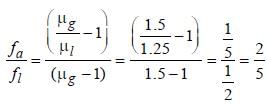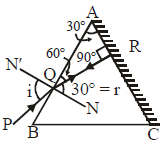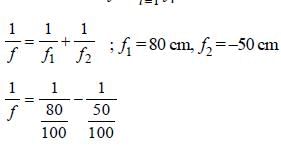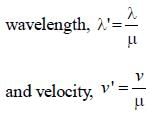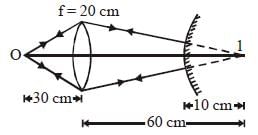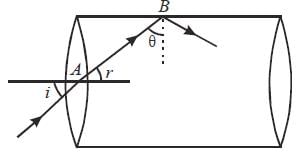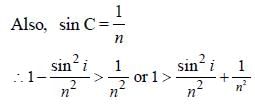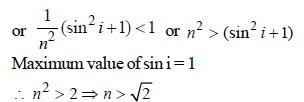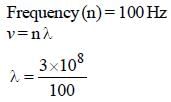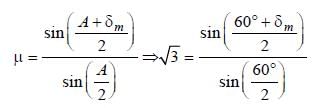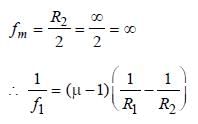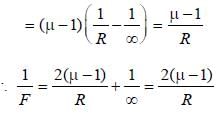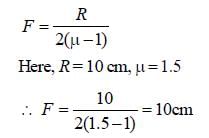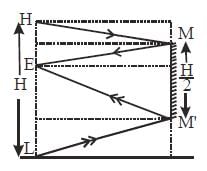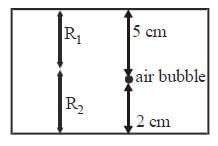31 Year NEET Previous Year Questions: Ray Optics & Optical Instruments - 2 - NEET MCQ
30 Questions MCQ Test Physics Class 12 - 31 Year NEET Previous Year Questions: Ray Optics & Optical Instruments - 2
Focal length of a convex lens of refractive index1.5 is 2 cm. Focal length of the lens whenimmersed in a liquid of refractive index of 1.25 will be [1988]
Ray optics is valid, when characteristicdimensions are [1989]
A ray is incident at an angle of incidence i on one surface of a prism of small angle A and emerges normally from the opposite surface. If the refractive index of the material of prism is μ, the angle of incidence i is nearly equal to [1989]
A beam of monochromatic light is refracted fromvacuum into a medium of refractive index 1.5,the wavelength of refracted light will be (1991]
Green light of wavelength 5460 Å is incident onan air-glass interface. If the refractive index ofglass is 1.5, the wave length of light in glasswould be (c = 3 × 108 ms–1) [1991]
There is a prism with refractive index equal to √2 and the refracting angle equal to 30°. One of the refracting surfaces of the prism is polished. A beam of monochromatic light will retrace its path if its angle of incidence over the refracting surface of the prism is [1992]
Time taken by sunlight to pass through a window of thickness 4 mm whose refractive index is 3/2 is [1993]
A point source of light is placed 4 m below thesurface of water of refractive index 5/3. Theminimum diameter of a disc, which should beplaced over the source, on the surface of waterto cut off all light coming out of water is [1994]
Angle of deviation (δ) by a prism (refractive index = μ and supposing the angle of prism A to be small) can be given by [1994]
Focal length of a convex lens will be maximumfor [1994]
An achromatic combination of lenses is formedby joining [1995]
The hypermetropia is a [1995]
If two mirrors are kept inclined at 60° to eachother and a body is placed at the middle, thentotal number of images formed is [1995]
A lens is placed between a source of light and a wall. It forms images of area A1 and A2 on the wall for its two different positions. The area of the source of light is [1995]
A convex lens of focal length 80 cm and aconcave lens of focal length 50 cm are combinedtogether. What will be their resulting power? [1996]
If fV and fR are the focal lengths of a convex lensfor violet and red light respectively and FV and FR are the focal lengths of concave lens for violetand red light respectively, then we have [1996]
Light travels through a glass plate of thickness t and refractive index μ. If c is the speed of light in vacuum, the time taken by light to travel this thickness of glass is
One face of a rectangular glass plate 6 cm thick issilvered. An object held 8 cm in front of the firstface forms an image 12 cm behind the silveredface. The refractive index of the glass is [1996]
The focal length of converging lens is measuredfor violet, green and red colours. It is respectively fv, fg, fr. We will get [1997]
An astronomical telescope has a length of 44 cmand tenfold magnification. The focal length ofthe objective lens is [1997]
An electromagnetic radiation of frequency n, wavelength λ, travelling with velocity v in air enters in a glass slab of refractive index (ν). The frequency, wavelength and velocity of light in the glass slab will be respectively [1997]
A luminous object is placed at a distance of 30 cm from the convex lens of focal length 20 cm. On theother side of the lens, at what distance from thelens a convex mirror of radius of curvature 10 cmbe placed in order to have an upright image of theobject coincident with it? [1998]
Light enters at an angle of incidence in atransparent rod of refractive index n. For whatvalue of the refractive index of the material ofthe rod the light once entered into it will notleave it through its lateral face whatsoever bethe value of angle of incidence? [1998]
A plano-convex lens is made of material ofrefractive index 1.6. The radius of curvature ofthe curved surface is 60 cm. The focal length ofthe lens is [1999]
Wavelength of light of frequency 100 Hz [1999]
The refractive index of the material of the prismis √3 ; then the angle of minimum deviation ofthe prism is [1999]
The radius of curvature of a thin plano-convexlens is 10 cm (of curved surface) and the refractiveindex is 1.5. If the plane surface is silvered, thenit behaves like a concave mirror of focal length [2000]
A person is six feet tall. How tall must a verticalmirror be if he is able to see his entire length?
Rainbow is formed due to a combination of [2000]
An air bubble in a glass slab (μ = 1.5) is 5 cmdeep when viewed from one face and 2 cm deepwhen viewed from the opposite face. Thethickness of the slab is [2000]
|
98 videos|334 docs|102 tests
|


